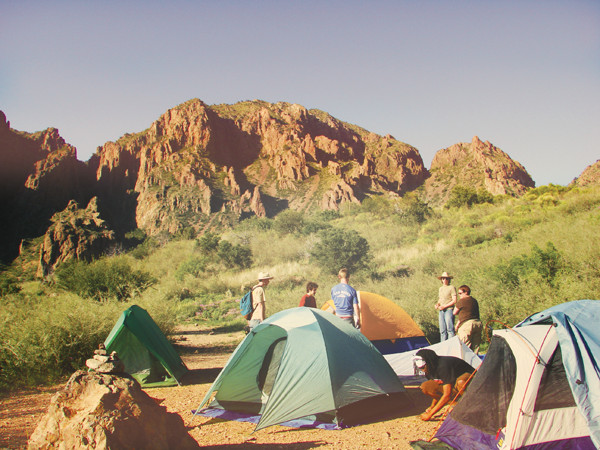
by Timothy Oleson Friday, July 19, 2013

A tent camp in the Chisos Mountains in Texas offers a temporary home for students during a regional geology field course run by the College of William and Mary. Jessica Ball
With a few exceptions — including available meal choices and entertainment options for when students have limited free time — accommodations at today’s field camps haven’t changed all that much, at least in the last few decades. Depending on the camp, however, lodging ranges from log cabins to college dorms to motels to the occasional traveling camps that still live and work out of “tent cities.”
Students at the Wasatch-Uinta consortium field camp have been staying in the same ski lodge in Park City, Utah, since the camp started in 1967. And participants at the University of Missouri’s field camp in Wyoming have long stayed in dorm-style log cabins built by students between the 1920s and 1940s.
Other than the current dining hall, built in 1990, or a few cabins reserved for instructors and their families when they visit, only the bath houses are plumbed, says camp director Miriam Barquero-Molina. The cabins do have electricity and the students get metal cots and 10-centimeter-thick vinyl mattresses on which to sleep. “The accommodations are fairly rustic,” Barquero-Molina says. “But you get a hot shower and three squares a day. I don’t think people can complain too much.”
The University of Kentucky’s field camp in Colorado operated out of tents — dining tents, cook tents, shower tents, latrine tents and more — until 1988, says camp director Frank Ettensohn. He notes that “students had as much problem adapting to [outdoor] life as they did hiking the mountains and doing the geology.”
The camp finally moved to dorms on the campus of Western State College in Gunnison, Colo., after the bridge to their longtime campsite rotted away and after their equipment — World War II surplus — started to deteriorate. Ettensohn says that outdoor-living skills can still be important for geologists, but now the students “don’t have to spend quite so much time just learning to accommodate to the outdoors” while they are also trying to learn the basics of field geology.
© 2008-2021. All rights reserved. Any copying, redistribution or retransmission of any of the contents of this service without the expressed written permission of the American Geosciences Institute is expressly prohibited. Click here for all copyright requests.